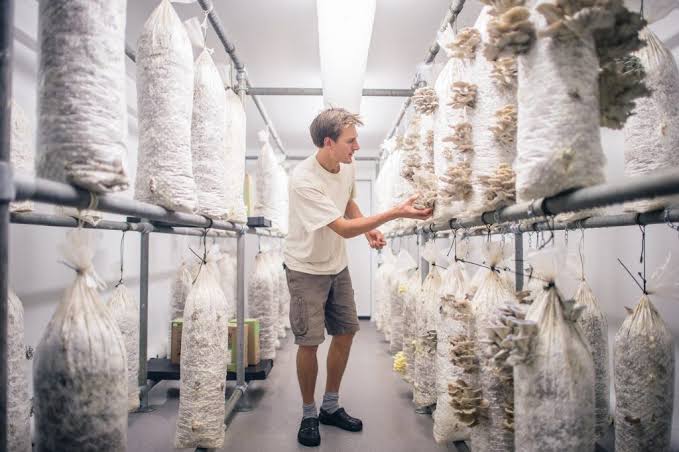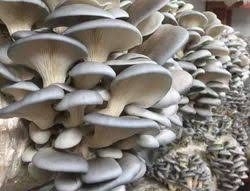Mushroom farming is a fascinating and rewarding venture that involves cultivating mushrooms for consumption or commercial purposes. It’s like growing your own little forest of delicious fungi.
To begin with, mushroom cultivation often starts with the selection of the right mushroom species. Common varieties include button mushrooms, oyster mushrooms, and shiitake mushrooms. Each type has its own specific requirements, so choosing the right one for your farm is crucial.
Once you’ve decided on the mushroom variety, the next step is preparing the growing medium. Mushrooms don’t grow in soil like traditional plants; instead, they thrive in a substrate. This substrate can be a mixture of materials like straw, wood chips, and other organic matter. Creating the perfect blend is like crafting a cozy home for your mushrooms to flourish.
After preparing the substrate, it’s time to inoculate it with mushroom spawn. Think of spawn as the mushroom’s version of seeds. It’s a mycelium-rich material that kick-starts the growth process. You mix the spawn with the substrate and let nature do its magic.
Temperature and humidity play crucial roles in mushroom cultivation. Mushrooms are quite picky about their living conditions. They prefer dark, cool, and humid environments. Managing these factors is like providing the ideal weather for your fungi friends to thrive and multiply.
As your mushrooms grow, you’ll notice tiny pins emerging from the substrate. These are the early stages of mushroom development. Patience is key during this stage, as it takes time for these pins to mature into fully-grown mushrooms. It’s like waiting for a garden to bloom with a unique and tasty harvest.
Harvesting mushrooms requires a delicate touch. Unlike traditional crops, you don’t pull them from the ground. Instead, you gently cut or twist the mature mushrooms from the substrate. It’s like picking ripe fruit from a tree, but with a more careful approach.
Mushroom farming isn’t just about growing food; it’s also an eco-friendly practice. Mushrooms are natural decomposers, breaking down organic matter and turning it into nutrient-rich soil. It’s like having tiny environmental superheroes in your farm, contributing to the circle of life.
In addition, mushroom farming is a simple yet intricate journey into the world of fungi. From selecting the right species to creating the perfect growing environment, each step is like a puzzle piece that contributes to the overall picture of a successful mushroom farm. So, whether you’re a curious hobbyist or an aspiring commercial farmer, mushroom cultivation offers a flavorful and fulfilling experience.
Beyond the basics, mushroom farming allows for creative exploration. Some enthusiasts experiment with different substrates or even explore advanced techniques like growing mushrooms on logs. It’s like being an artist, molding and sculpting the growing conditions to yield unique and delightful results.
Moreover, mushroom farming is accessible to people of various skill levels. Whether you’re a seasoned farmer or a beginner with a green thumb, the process is adaptable and forgiving. It’s like nature giving you a chance to learn and grow alongside your mushrooms.
One of the fascinating aspects of mushroom cultivation is its potential for year-round production. Unlike many traditional crops that are seasonal, mushrooms can be cultivated indoors, providing a consistent supply. It’s like having a miniature garden that defies the limitations of weather and climate.
The health benefits of mushrooms add another layer of appeal to this farming endeavor. Many mushroom varieties are rich in essential nutrients, low in calories, and boast medicinal properties. Incorporating homegrown mushrooms into your diet is like adding a nutritious boost to your meals, all thanks to your own efforts.
Mushroom farming isn’t just about cultivation; it also opens doors to various culinary adventures. With a bountiful harvest in hand, you can explore diverse recipes, from simple sautés to gourmet dishes. It’s like having a versatile ingredient that adds a unique flavor profile to your kitchen creations.
Additionally, the market for mushrooms continues to grow globally. Whether you choose to sell your harvest locally or venture into larger markets, mushroom farming can be a sustainable source of income. It’s like turning your hobby into a small business, with the added satisfaction of providing a sought-after and healthy product.
As you delve deeper into mushroom farming, you’ll discover the interconnectedness of nature. Mycelium, the intricate network that forms the basis of mushrooms, acts as nature’s internet, facilitating communication between plants and aiding in nutrient exchange. It’s like witnessing a silent symphony of life beneath the surface of your mushroom farm.
In essence, mushroom farming is a journey that goes beyond the simplicity of planting and harvesting. It’s a holistic experience that engages your senses, challenges your skills, and connects you with the wonders of the natural world. So, whether you’re motivated by a desire for sustainable living, a passion for agriculture, or the joy of growing your own food, mushroom farming offers a fulfilling and enriching adventure.
Read Also: Reproduction and Management Practices in Snail Business
Techniques Used in Mushroom Farming

Mushroom farming involves various techniques to ensure a successful harvest. Understanding these techniques can help you fine-tune your approach and optimize your mushroom cultivation process.
1. Sterilization: Ensuring a sterile environment is crucial in mushroom farming. This involves sterilizing the substrate to eliminate any competing organisms that might hinder mushroom growth. Techniques include pressure cooking, steam sterilization, or using chemical agents to create a clean slate for the mycelium to thrive.
2. Inoculation: The inoculation process involves introducing mushroom spawn to the substrate. This can be done through methods like grain-to-grain transfer or agar inoculation. It’s akin to planting seeds in a garden, kickstarting the growth of mycelium that will later give rise to mushrooms.
3. Incubation: After inoculation, the substrate and spawn need time to bond and develop a robust mycelial network. This incubation period requires a controlled environment with specific temperature and humidity levels. Think of it as providing a cozy nursery for your mushrooms to grow strong.
4. Fruiting Conditions: Creating the right conditions for fruiting is essential. Adjusting temperature, humidity, and fresh air exchange mimics the natural environment that triggers mushrooms to emerge. It’s like orchestrating a symphony of atmospheric factors to coax your mushrooms into their final stage of development.
5. Harvesting Techniques: Knowing when and how to harvest is an art. Harvesting too early or too late can affect the quality of your mushrooms. Gently twisting or cutting mature mushrooms at the base without disturbing the rest of the substrate ensures a clean harvest. It’s akin to delicately plucking ripe fruit from a tree.
6. Spawning to Bulk Substrate: Some cultivators use a method called spawning to bulk substrate, where the mycelium is transferred to a larger growing medium. This technique allows for increased mushroom yields. It’s like transplanting seedlings into a larger garden bed to promote more abundant growth.
7. Casing Layer Application: For certain mushroom varieties, adding a casing layer on top of the substrate can enhance moisture retention and promote even pin set. This layer acts as a protective covering, creating optimal conditions for mushroom formation. It’s similar to providing a protective layer of mulch in a traditional garden.
8. Pest and Contamination Management: Vigilance against pests and contaminants is crucial. Regular monitoring and swift action against unwanted invaders safeguard the health of your mushroom crop. It’s like maintaining a pest-free zone to ensure the well-being of your cultivated fungi.
However, mastering these techniques turns mushroom farming into a precise and rewarding practice. Each step contributes to the overall success of your cultivation efforts, emphasizing the delicate balance between nature and the controlled environment you provide for your fungi friends.
Read Also: Processing and Marketing of Snails in Snail Business
Benefits of Mushroom Farming

Mushroom farming offers a plethora of benefits, ranging from nutritional advantages to environmental sustainability. Let’s see the diverse merits of cultivating these unique fungi.
1. Nutritional Value: Mushrooms are a rich source of essential nutrients such as vitamins (B, D), minerals (selenium, potassium), and antioxidants. Including homegrown mushrooms in your diet can contribute to overall health and well-being.
2. Sustainable Farming: Mushrooms are efficient decomposers, breaking down organic matter. This makes mushroom farming an eco-friendly practice, as it contributes to recycling agricultural waste and promotes sustainable land use.
3. Year-Round Production: Indoor mushroom cultivation allows for year-round production, overcoming the limitations of seasonal farming. This consistent supply ensures a steady source of fresh mushrooms regardless of external weather conditions.
4. Medicinal Properties: Certain mushroom varieties boast medicinal properties. For example, shiitake mushrooms contain compounds believed to support the immune system. Integrating these health benefits into your diet is like having a natural pharmacy at your fingertips.
5. Culinary Versatility: Mushrooms are incredibly versatile in the kitchen. They can be used in a variety of dishes, from soups and stir-fries to gourmet meals. Growing your own mushrooms opens up a world of culinary creativity and unique flavors.
6. Economic Opportunities: Mushroom farming presents economic opportunities for small-scale and commercial growers. With a growing demand for specialty mushrooms, cultivating and selling your harvest can be a sustainable source of income.
7. Soil Improvement: As mushrooms break down organic matter, they contribute to soil improvement. The by-products of mushroom farming can be used as nutrient-rich compost, enhancing soil fertility for other crops.
8. Low Space Requirements: Mushroom cultivation doesn’t require vast agricultural spaces. It can be done in relatively small areas or even indoors, making it accessible to urban dwellers or those with limited land.
9. Educational Value: Engaging in mushroom farming provides a hands-on educational experience. It teaches principles of biology, mycology, and ecology. It’s like having a living laboratory in your backyard or indoors.
10. Connection with Nature: Mushroom farming fosters a deeper connection with nature. Observing the life cycle of mushrooms, from spore to harvest, provides a sense of appreciation for the natural world and its intricate processes.
In summary, mushroom farming extends its benefits beyond the dinner table. It encompasses health, sustainability, economic viability, and a holistic understanding of nature. Whether you’re a health-conscious individual, an aspiring entrepreneur, or someone with a green thumb, mushroom farming offers a multifaceted array of advantages.
Read Also: Amazing 35 Real Ways to Make Money Online
